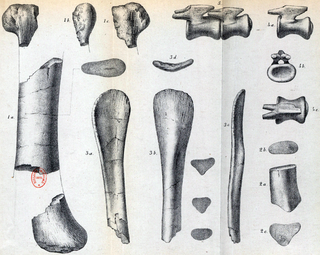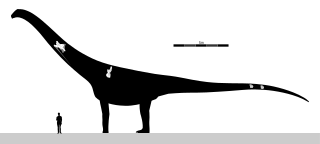
Ankylosaurus is a genus of armored dinosaur. Its fossils have been found in geological formations dating to the very end of the Cretaceous Period, about 68–66 million years ago, in western North America, making it among the last of the non-avian dinosaurs. It was named by Barnum Brown in 1908; the only species in the genus is A. magniventris. The genus name means "fused lizard", and the specific name means "great belly". A handful of specimens have been excavated to date, but a complete skeleton has not been discovered. Though other members of Ankylosauria are represented by more extensive fossil material, Ankylosaurus is often considered the archetypal member of its group, despite having some unusual features.

Sauroposeidon is a genus of sauropod dinosaur known from several incomplete specimens including a bone bed and fossilized trackways that have been found in the American states of Oklahoma, Wyoming, and Texas. The fossils were found in rocks dating from near the end of the Early Cretaceous, a time when sauropod diversity in North America had greatly diminished. It was the last known North American sauropod prior to an absence of the group on the continent of roughly 40 million years that ended with the appearance of Alamosaurus during the Maastrichtian.

Aeolosaurus is a genus of titanosaurian sauropod dinosaur from the Late Cretaceous Period of what is now South America. Like most sauropods, it would have been a quadrupedal herbivore with a long neck and tail. Aeolosaurus is well known for a titanosaur, as it is represented by the remains of several individuals belonging to at least three species. However, like most titanosaurs, no remains of the skull are known. The holotype of Aeolosaurus rionegrinus consists of a series of seven tail vertebrae, as well as parts of both forelimbs and the right hindlimb. It was discovered in the Angostura Colorada Formation in Argentina, which dates from the Campanian stage of the Late Cretaceous, about 83 to 74 million years ago.

Koolasuchus is an extinct genus of brachyopoid temnospondyl in the family Chigutisauridae. Fossils have been found from Victoria, Australia and date back 120 Ma to the Aptian stage of the Early Cretaceous. Koolasuchus is the youngest known temnospondyl. Koolasuchus is known from several fragments of the skull and other bones such as vertebrae, ribs, and pectoral elements. The type species Koolasuchus cleelandi was named in 1997.

Altispinax is a genus of large predatory theropod dinosaur from the Early Cretaceous Wadhurst Clay Formation of East Sussex, England.

Magyarosaurus is a genus of dwarf sauropod dinosaur from late Cretaceous Period in Romania. It is one of the smallest-known adult sauropods, measuring only six meters in length. The type and only certain species is Magyarosaurus dacus. It has been found to be a close relative of Rapetosaurus in the family Saltasauridae in the sauropod clade Titanosauria in a 2005 study.

Hypselosaurus was a dubious titanosaurian sauropod that lived in southern France during the Late Cretaceous, approximately 70 million years ago in the early Maastrichtian. Hypselosaurus was first described in 1846, but was not formally named until 1869, when Phillip Matheron named it under the binomial Hypselosaurus priscus. The holotype specimen includes a partial hindlimb and a pair of caudal vertebrae, and two eggshell fragments were found alongside these bones. Because of the proximity of these eggshells to the fossil remains, many later authors, including Matheron and Paul Gervais, have assigned several eggs from the same region of France all to Hypselosaurus, although the variation and differences between these eggs suggest that they do not all belong to the same taxon. Hypselosaurus has been found in the same formation as the dromaeosaurids Variraptor and Pyroraptor, the ornithopod Rhabdodon, and the ankylosaurian Rhodanosaurus, as well as indeterminate bones from other groups.

Laplatasaurus is a genus of titanosaurian sauropod dinosaur that lived during the Late Cretaceous in South America.

Rinconsaurus is a genus of dinosaur from the Late Cretaceous. It was a titanosaurid sauropod which lived in what is now Argentina. The type species, Rinconsaurus caudamirus, was described by Calvo and Riga in 2003, and is based on three partial skeletons.

Puertasaurus is a genus of sauropod dinosaur that lived in South America during the Late Cretaceous Period. It is known from a single specimen recovered from sedimentary rocks of the Cerro Fortaleza Formation in southwestern Patagonia, Argentina, which probably is Campanian or Maastrichtian in age. The only species is Puertasaurus reuili. Described by the paleontologist Fernando Novas and colleagues in 2005, it was named in honor of Pablo Puerta and Santiago Reuil, who discovered and prepared the specimen. It consists of four well-preserved vertebrae, including one cervical, one dorsal, and two caudal vertebrae. Puertasaurus is a member of Titanosauria, the dominant group of sauropods during the Cretaceous.

Camarasauridae is a family of neosauropod dinosaurs within the clade Macronaria, the sister group to Titanosauriformes. Among sauropods, camarasaurids are small to medium-sized, with relatively short necks. They are visually identifiable by a short skull with large nares, and broad, spatulate teeth filling a thick jaw. Based on cervical vertebrae and cervical rib biomechanics, camarasaurids most likely moved their necks in a vertical, rather than horizontal, sweeping motion, in contrast to most diplodocids. Cladistically, they are defined to be all sauropods more closely related to Camarasaurus supremus than to Saltasaurus loricatus.
Balochisaurus is a genus of titanosaurian sauropod dinosaur from the Late Cretaceous of Pakistan. The type species is B. malkani. The discovery was made near Vitariki by a team of paleontologists from the Geological Survey of Pakistan. Formally described in 2006 by M.S. Malkani, the genus is based on seven tail vertebrae found in the Maastrichtian-age Vitakri Member of the Pab Formation, with additional vertebrae and a partial skull assigned to it. Balochisaurus was assigned to the family Balochisauridae along with Marisaurus, although the family was used as a synonym of older Saltasauridae.
Brohisaurus is a genus of titanosauriform sauropod dinosaur from the Late Jurassic, based on largely indeterminate fragments of some ribs, vertebrae, and limb bones. The type and only species, B. kirthari, was described by M. Sadiq Malkani in 2003. The genus name means "Brohi lizard" and refers to the Brohi people who live in the area where it was found. The species name refers to the Kirthar Mountains. The fossils were discovered in the lowest portion of the Kimmeridgian Sembar Formation from the Kirthar foldbelt in Pakistan.
Khetranisaurus is a genus of titanosaurian sauropod from the Late Cretaceous of Balochistan, western Pakistan. The type species is K. barkhani, described by M. Sadiq Malkani in 2006, and it is based on a tail vertebra, found in the Maastrichtian-age Vitakri Member of the Pab Formation. It was assigned to Pakisauridae, along with Pakisaurus and Sulaimanisaurus.
Pakisaurus is a genus of titanosaurian sauropod from the Late Cretaceous of Balochistan, western Pakistan. The type species is P. balochistani, and it was validly named by M. Sadiq Malkani in 2006, based on four tail vertebrae, found in the Maastrichtian-age Vitakri Member of the Pab Formation. Three additional tail vertebrae have been assigned to it. The author erected the family Pakisauridae, using it synonymously with older Titanosauridae. Pakisaurus was decided to be closely related to Sulaimanisaurus and Khetranisaurus, both from Pakistan as well.
Sulaimanisaurus is a genus of titanosaurian sauropod from the Late Cretaceous of Balochistan, western Pakistan. The type species is S. gingerichi, described by M. Sadiq Malkani in 2006, and it is based on seven tail vertebra, found in the Maastrichtian-age Vitakri Member of the Pab Formation. Four additional tail vertebrae have been assigned to it. It was considered to be related to Pakisaurus and Khetranisaurus in the family Pakisauridae.
Vitakridrinda is a genus of abelisaurid theropod dinosaur from the Late Cretaceous of Balochistan, western Pakistan. The type species is V. sulaimani. The discovery was made near Vitariki by a team of palaeontologists from the Geological Survey of Pakistan, in rocks from the Maastrichtian-age Vitakri Member of the Pab Formation. Formally described in 2006 by M.S. Malkani, the genus is based on partial remains including two thigh bones, a braincase, and a tooth. A partial snout was later found that Malkani assigned to the holotype, and additional vertebrae may also belong to this genus. However, the snout was later reclassified as a new genus of mesoeucrocodylian, Induszalim.
Pabwehshi is an extinct genus of mesoeucrocodylian. It is based on GSP-UM 2000, a partial snout and corresponding lower jaw elements, with another snout assigned to it. These specimens were found in Maastrichtian-age Upper Cretaceous rocks of the Pab Formation in Balochistan, Pakistan, and represent the first diagnostic crocodyliform fossils from Cretaceous rocks of South Asia. Pabwehshi had serrated interlocking teeth in its snout that formed a "zig-zag" cutting edge. Pabwehshi was named in 2001 by Jeffrey A. Wilson and colleagues. The type species is P. pakistanensis, in reference to the nation where it was found. It was traditionally classified as a baurusuchid closely related to Cynodontosuchus and Baurusuchus. Larsson and Sues (2007) found close affinity between Pabwehshi and the Peirosauridae within Sebecia. Montefeltro et al.Pabwehshi has a sagittal torus on its maxillary palatal shelves – a character that is absent in baurusuchids – but they did not include Pabwehshi in their phylogenetic analysis.
Vitakrisaurus is a genus of noasaurid theropod dinosaurs represented by only one known species, Vitakrisaurus saraiki. It lived in the late Cretaceous period, approximately 70 million years ago, during the Maastrichtian, in what is today the Indian subcontinent. Its fossils were found in Pakistan's Vitraki Formation. The holotype specimen, MSM-303-2 is a right foot with a seemingly tridactyl form and robust phalanges. It may belong to a noasaurid due to similarities with the foot of Velocisaurus, although inconsistencies within its brief description and a lack of comparison with other theropods within the article makes formal classification difficult.

























